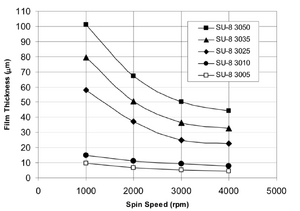SU-8: Difference between revisions
Jump to navigation
Jump to search
No edit summary |
No edit summary |
||
| (One intermediate revision by the same user not shown) | |||
| Line 1: | Line 1: | ||
SU-8 is a negative, epoxy based, near-UV photoresist designed for MEMS and other microelectronic applications. It was originally developed and patented by IBM. SU-8 is processed using standard lithography techniques. When SU-8 is exposed to UV light its molecular chains cross-link, causing the SU-8 to solidify. SU-8 is highly transparent in the ultraviolet range. This allows for the fabrication of relatively thick (hundreds of micrometers) structures with nearly vertical side walls. Two companies have licenses from IBM to sell SU-8: MicroChem and Gersteltec. | SU-8 is a negative, epoxy based, near-UV photoresist designed for MEMS and other microelectronic applications. It was originally developed and patented by IBM. SU-8 is processed using standard lithography techniques. When SU-8 is exposed to UV light its molecular chains cross-link, causing the SU-8 to solidify. SU-8 is highly transparent in the ultraviolet range. This allows for the fabrication of relatively thick (hundreds of micrometers) structures with nearly vertical side walls. Two companies have licenses from IBM to sell SU-8: MicroChem and Gersteltec. | ||
[[File:SU83000_SC.png|thumb| | [[File:SU83000_SC.png|thumb|centre|Spin curve of SU-8 3000 series. SU-8 3000 Thickness vs. Spin Speed.]] | ||
In the Cleanroom of the University of Copnehagen we provide '''SU-8 3050'''. | |||
Recommended developer: '''mr-Dev 600''' | |||
=Technical datasheets= | =Technical datasheets= | ||
* SU-8 3000 series [https://kayakuam.com/wp-content/uploads/2020/07/KAM-SU-8-3000-Datasheet-7.10-final.pdf] | * SU-8 3000 series [https://kayakuam.com/wp-content/uploads/2020/07/KAM-SU-8-3000-Datasheet-7.10-final.pdf] | ||
* SU-8 2000 series [https://kayakuam.com/wp-content/uploads/2019/09/SU-82000DataSheet2025thru2075Ver4-3.pdf] | * SU-8 2000 series [https://kayakuam.com/wp-content/uploads/2019/09/SU-82000DataSheet2025thru2075Ver4-3.pdf] | ||
=Fabrication recipe= | |||
== Dehydration== | |||
# Place your wafer on a hotplate for t=10 minutes at T=185˚C. | |||
# Let the wafer cool down. | |||
== Spin coat== | |||
# Dispense 1 ml of resist for each inch (25 mm) of substrate diameter (4ml for a 4 inch wafer) | |||
# Spin at 500 rpm for 5-10 sec with acceleration of 100 rpm/second | |||
# Spin at 3000 rpm for 30 sec with acceleration of 300 rpm/second | |||
# Soft bake at 95C for 15 mins | |||
== Expose pattern with upg501 Heidelberg== | |||
==Post bake exposure== | |||
# 95C for 5 mins | |||
: Post bake exposure should take place directly after exposure | |||
== Development== | |||
# Develop for 10 minutes in developer mr-Dev 600 | |||
# Rinse for 30 seconds in Isopropyl Alcohol (IPA) | |||
# Dry with N2 gun | |||
=Information from other institutes= | =Information from other institutes= | ||
* Kavli Nanolab Delft [https://filelist.tudelft.nl/TNW/Afdelingen/Quantum%20Nanoscience/Kavli%20Nanolab%20Delft/Equipment/Recipe%20using%20SU8-3050.pdf] | * Kavli Nanolab Delft [https://filelist.tudelft.nl/TNW/Afdelingen/Quantum%20Nanoscience/Kavli%20Nanolab%20Delft/Equipment/Recipe%20using%20SU8-3050.pdf] | ||
* Brigham Young University, Integrated Microfabrication Lab [https://cleanroom.byu.edu/su-8-information-page] | * Brigham Young University, Integrated Microfabrication Lab [https://cleanroom.byu.edu/su-8-information-page] | ||
Latest revision as of 12:25, 6 August 2025
SU-8 is a negative, epoxy based, near-UV photoresist designed for MEMS and other microelectronic applications. It was originally developed and patented by IBM. SU-8 is processed using standard lithography techniques. When SU-8 is exposed to UV light its molecular chains cross-link, causing the SU-8 to solidify. SU-8 is highly transparent in the ultraviolet range. This allows for the fabrication of relatively thick (hundreds of micrometers) structures with nearly vertical side walls. Two companies have licenses from IBM to sell SU-8: MicroChem and Gersteltec.

In the Cleanroom of the University of Copnehagen we provide SU-8 3050.
Recommended developer: mr-Dev 600
Technical datasheets
Fabrication recipe
Dehydration
- Place your wafer on a hotplate for t=10 minutes at T=185˚C.
- Let the wafer cool down.
Spin coat
- Dispense 1 ml of resist for each inch (25 mm) of substrate diameter (4ml for a 4 inch wafer)
- Spin at 500 rpm for 5-10 sec with acceleration of 100 rpm/second
- Spin at 3000 rpm for 30 sec with acceleration of 300 rpm/second
- Soft bake at 95C for 15 mins
Expose pattern with upg501 Heidelberg
Post bake exposure
- 95C for 5 mins
- Post bake exposure should take place directly after exposure
Development
- Develop for 10 minutes in developer mr-Dev 600
- Rinse for 30 seconds in Isopropyl Alcohol (IPA)
- Dry with N2 gun